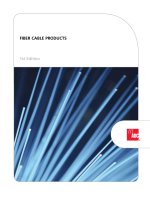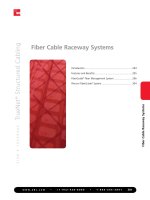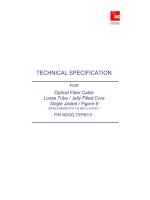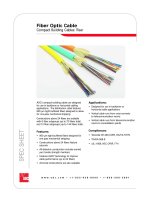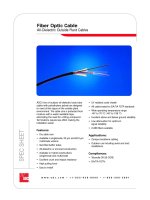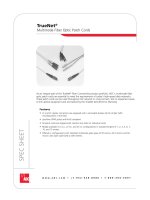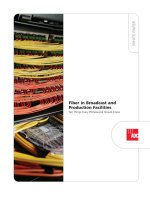Tài liệu ADC KRONE - Guide - FO - Field Performance Testing of Fiber Link - ISO 11801 ppt
Bạn đang xem bản rút gọn của tài liệu. Xem và tải ngay bản đầy đủ của tài liệu tại đây (334.6 KB, 12 trang )
PERFORMANCE TESTING
OF OPTICAL FIBRE LINKS
FOR COMPLIANCE TO ISO/IEC 11801
Using the test methods set out in ISO/IEC 14763-3 - Testing of optical fibre cabling
Main changes from previous Version 6;
Item 8 3-Test Cord Method for Reference Setting is default method
Item 10 Field Calibration Cord, Launch & Tail Cords shall all have Reference Connectors
Item 11 Method of Removal of Field Calibration Cord Adaptors for Link Testing
Item 14 Insertion Loss for Reference and Non-Reference Connectors
Item 15 Example of Loss Budget Calculation Updated for Reference Connectors
Item 16 Links of 1/10GBE or any Channel to be Tested in 2 x Dir. at 2 x Wavelengths
Item 16 Links of Known Connectors for non-1/10GBE runs can be Tested in 1 x Dir.
Item 17 Qualification of Launch Cords
Item 17 Use adaptors at power meter to suit the Launch Cord & Tail Cord as necessary.
Item 18 Qualification of Tail & Field Calibration Cords
Item 19 The 3-Test Cord Reference Setting Method
Item 21 Reference Setting on LSPM Using the 1-Test Cord Method
Item 22 Qualification of Tail Cord for 1-Test Cord Method
Item 23 The 1-Test Cord Reference Setting Method for Non-1/10GBE Installations
Item 24 Effects of Different Zeroing Methods on Loss Budget
Appendix A Set Up for Fluke DSP Series with Fibre Test Head as an LSPM Tester
Appendix B TIA 568-C.3 draft requirements added for American projects
3-Test Cord Method
Reference Setting
Is Default Method
The 3-Test Cord Method produces more accurate test results with better consistency.
Version 7_1&3T Draft 2
ADC KRONE (Asia Pacific)
OF Testing ADC KRONE Requirements V7_1&3T Dr2Page 1 of 12
OPTICAL FIBRE TESTING FOR COMPLIANCE TO ISO/IEC 11801
1
All Optical Fibres, including Per-Terminated Optical Fibres shall be CLEANED after
installation and tested as a LINK for:
0
Visual inspection of all ends
Recommended
1
Continuity and Maintenance of Polarity
Required
2
Length
Required
3
Propagation Delay
Required
4
Optical Attenuation of Link: 2 x wavelengths
Required (See Item 16)
[LINK testing includes the 2 x end connectors. CHANNEL testing does not include the 2 x end connectors.]
2
Visual inspection is not mandatory but if done, use a minimum x100 magnification for MMF,
x200 for SMF, both conducted to protect the viewer’s eyes. The core is a ”PASS” if it is
round, clear & featureless. The inner 1/2 of cladding is a ”PASS” if it is free of chips & cracks
but it may have some polishing marks. The outer 1/2 of cladding may contain some polishing
marks and chips but any chips must be less than 25% of the cladding circumference.
3
Continuity and Maintenance of Polarity of each optical fibre termination is checked
ensuring that “A” at the Near-End is “B” at the Far-End, and visa-versa. This can be done by;
1. visible light (eg a red light source) and inspecting opposite ends at the same time, or
2. using an LSPM that has been connected to the fibre at the far end, or
3. using an OTDR with a ‘tail cord’ connected to the correct fibre at the far end.
4
Length is verified by recording the cable length markings at each end and subtracting one
from the other, or by reading the length off a tester.
5
Propagation Delay PD is a calculation based on;
6
Optical Attenuation (Power Loss or Insertion Loss) tests must be done at both wavelengths
and in both directions for 1/10GBE applications (See Item 16). This will check for any
connector or splice defects, any cracked connectors, any accidental splicing or connecting of
50 μm and 62.5 μm fibres.
7
Power Loss (or Insertion Loss or Optical Attenuation) tests can be done using either,
Light Source & Power Meter
(LSPM), or
Optical Time Domain Reflectometer
(OTDR)
See Item 16.
PD = 5.0 nano-seconds/metre.
PD (in nS) = 5 x length (m).
Some testers are capable of measuring and recording PD; otherwise it must be calculated
and written on the Test Result Sheet for each fibre cable.
If conflict exists, correct testing using LSPM shall be taken as correct.
Where LSPM results exceed the Power Loss Budget, the link should be investigated with an
OTDR to determine the faulty component.
8
Reference Setting (Zeroing) Methods for LSPM Testers on MMF and SMF
Are the connectors on the LSPM tester the same as the connectors on the Link to be tested?
Is the test set-up for Simplex only testing?
NO
– Use the 3-Test Cord Method of Reference Setting
(Eg. SC on Tester and LC on Link)
YES – Use either 3-Test Cord Method or 1-Test Cord Method of Reference Setting
(Eg. SC on tester and SC on both ends of Link)
OF Testing ADC KRONE Requirements V7_1&3T Dr2Page 2 of 12
9
Use of Mandrels or Coils (for both 3 & 1-Test Cord Methods)
For MMF, the LSPM Tester must have the correct Coupling Power Ratio for the cable under
test. Alternatively, this can be achieved by using a Mandrel Wrap on the Launch Cord for
mode stripping during Reference Setting and Testing.
For a 3 mm Launch Cord,
5 turns on 17 mm Ø for 62.5 µm (OM1)
5 turns on 22 mm Ø for 50 µm (OM2 and OM3)
For SMF, the LSPM launch cord shall have at least 2 x turns of 40±5 mm diameter, air-coiled
or on a mandrel, for stripping light out of the cladding and more consistent readings.
10
Test Cords and Field Calibration Cords (for both 3 & 1-Test Cord Methods)
All Test Cords & Field Calibration cords shall be Qualified. (See Item 17 for procedure)
Launch and Tail Cords for MMF & SMF LSPM testing shall be 1m to 5m each and shall
have a Reference Connector at one end.
Field Calibration Cord shall not exceed 2m in length and shall have Reference Connectors
at both ends.
Reference Connectors shall be the same type of connectors as the cabling to be tested.
Mated Reference Connectors shall have an attenuation of
≤ 0.10 dB for MMF, and ≤ 0.20 dB for SMF.
11
Field Calibration Cord and Adaptor Removal (for 3-Test Cord Method)
For both MMF and SMF cabling, after the 3-Test Cord Reference Setting has been done, the
central Field Calibration Cord shall be removed and the cabling under test connected.
For a Link,
the 2 x adaptors are removed with the field calibration cord.
[For a Channel,
the 2 x adaptors remain on the launch and tail cords.]
12
Acceptance criteria is;
1.
2.
3.
4.
13
14
Continuity & Polarity shall be correct, and
Length shall be recorded, and
Propogation Delay shall be recorded, and
Optical Attenuation (Power Loss) test result shall be less than the Power Loss Budget at
both the nominated wavelengths in both directions for 1/10GBE installations. (Item 16)
Power Loss Budget (PLB) in dB is the sum of the maximum component insertion loss
allowed under ISO/IEC 11801 Table 4, AS/NZS 3080, Cl 9.4 Table 26, and Cl 10.3 Table 46.
These requirements are set out in Item 14.
Component Power Loss
Component and
Wavelength
Mated Ref to Non-Ref
Connector at 850 & 1300 nm
at 1310 & 1550 nm
ISO/IEC 11801
Insertion Loss Maximum
1/2
1/2
See Note 1
MMF 0.30 dB
SMF 0.50 dB
Splice
at 850 & 1300 nm
and at 1310 & 1550 nm
0.30 dB
1 x Mated Connection
i.e. one Ref/Non-Ref Connection
MMF
at 850 nm
at 1300 nm
3.50 dB/km
1.50 dB/km
at 1310 & 1550 nm
1.00 dB/km
SMF
Reference Connector
Connector on installed cabling
Connector device (general)
Note 1 Insertion Loss
Mated Reference to Reference Connector is 0.10 dB MMF and 0.20 dB SMF
Mated Reference to Non-Reference Connector is
0.30 dB MMF and 0.50 dB SMF
Mated Non-Reference to Non-Reference Connector is 0.75 dB MMF and SMF
{ Ref ISO/IEC 14763-3 Tables 3 & 4}
OF Testing ADC KRONE Requirements V7_1&3T Dr2Page 3 of 12
FD
1
1m Splice
15
Example A fibre link consists of 198m OM3,
50/125 µm cable. In addition, there is a 1m
pigtail splice inside the FOBOT at each end.
What is the Power Loss Budget?
198m
1m Splice
At Launch Cord & Tail Cord
1
ER
Item 15 Example
PLB850
PLB850
PLB850
= 2 x Ref/Non-Ref Connectors matings + 2 x splices + 0.2 km x MMF
= 2 x 0.30 + 2 x 0.30 + 0.2 x 3.50
= 1.90 dB maximum @ 850 nm
PLB1300
PLB1300
PLB1300
= 2 x Ref/Non-Ref Connector matings + 2 x splice + 0.2km x MMF
= 2 x 0.30 + 2 x 0.30 + 0.2 x 1.50
= 1.50 dB maximum @ 1300 nm
Therefore, the tester readings must be less than the maximum Power Loss Budget of;
PLB850
PLB1300
16
= 1.90 dB
= 1.50 dB
There must always be a power loss. If
there is a power gain, testers need a
new Reference Setting. See Item 19.
Test Wavelength and Direction
Horizontal & Backbone Cabling, Within The Same Building
Where the MMF and SMF Link is to be used for 1/10GBE or is a channel or has unknown
connectors, the test shall be done at:
Both wavelengths,
in 2 x direction
using LSPM Launch & Tail Cords.
The single reported Test Result at each wavelength shall be the single highest reading from
{ Ref ISO/IEC 14763-3 Cl 9.1.1.3}
either direction, recorded to at least 2 decimal places.
(Not the lowest reading, and not an average reading of both directions for LSPM testing)
Some installers choose to use only OTDR testing and not do LSPM testing. If this is done,
ADC KRONE will only accept the results if the average highest OTDR reading from both
directions is calculated and written into an electronic record of results along with the PLB.
For MMF and SMF Links that have known connectors and are not for 1/10GBE, test at;
Both wavelengths,
in just 1 x direction
using LSPM Launch & Tail Cords.
Inter-building Campus Cabling
Use LSPM
2 x wavelengths, both in 2 x directions, AND ALSO
Use OTDR
For Links less than 300m,
It is not an ADC KRONE requirement.
For Links over 300m long,
It is an ADC KRONE requirement.
2 x wavelengths, both in 2 x directions, using OTDR launch and tail cords
For OTDR tests, the single reported Test Result at each wavelength shall be the average of
the highest readings from both directions.
{Ref ISO/IEC 14763-3 Cl 9.1.2.4}
[Because the scattering coefficients are usually different between launch cord, cable under test, and tail cord, the test
results will be different when tested in different directions. Therefore the readings are to be averaged.]
Some installers choose to use only OTDR testing and not do LSPM testing. If this is done,
ADC KRONE will only accept the results if the average highest reading from both directions is
calculated and written into an electronic record of results along with the PLB.
Launch & Tail Cord Lengths
LSPM launch & tail cords are each
OTDR launch & tail cords are typically
→
Launch cord
Tail cord
OF Testing ADC KRONE Requirements V7_1&3T Dr2Page 4 of 12
1–5m
100 m min
50 m min
17
Qualification of Launch Cord
(Step 1)
Launch & Tail Cords shall have Reference Connectors one end, tester connectors other end.
Field Calibration Cords shall have Reference Connectors on both ends. (See Item 10)
For MMF, apply a Mandrel Wrap in the Launch Cord L1,
For SMF, apply coils in the Launch Cord L1
5 turns on 17 mm Ø for 62.5 µm
5 turns on 22 mm Ø for 50 µm
at least 2 x turns of 40±5mm
diameter air-coiled or on a mandrel.
Clean both the test cord connector ends. Connect L1 at the light source. Use an adaptor to
suit the cord at the power meter and connect. The adaptor is not included in the test results.
Place the test cord in such a way as to minimise movement during testing.
Turn on the light source and power meter and let them stabilise for several minutes.
Most meters allow you to set this reading to “0.00 dB”. The LSPM is now referenced to “Zero”.
.
L1
Light
Source
18
DO NOT disconnect L1
from the light source.
If disconnection
occurs, repeat Step 1.
Use an adaptor
to suit the cord
Power
Meter
Qualification of Tail Cord or Field Calibration Cord
(Step 2)
Disconnect L1 from the Power Meter. Clean the test cord connector ends and apply a
Reference Adaptor (eg SMF adaptor) at the centre connection. Insert Tail Cord T1.
This second cord is acceptable if the power loss is less than 0.10 dB for MMF and 0.20 dB for
SMF {Ref ISO/IEC 14763-3 Cl D.2.}
Loss
Reference
Connector
L1
Light
Source
Reference
Connector
Use an
adaptor
to suit
the cord
T1
Power
Meter
≤ 0.10 dB for MMF
≤ 0.20 dB for SMF
DO NOT turn off the light
source or power meter
between measurements.
If the reading is greater than 0.10 dB or 0.20 dB for MMF or SMF, repeat Step 2 after cleaning
the connectors, or use another test cord.
Repeat the Step 2 qualification process on as many test cords as is necessary to undertake
the LSPM testing. If duplex testing is done with the 3-Test Cord Method, the required cords
are;
2 x Launch Cords L1
each the same length
between 1m – 5m long
2 x Tail Cords T1
each the same length as L1
between 1m – 5m long
2 x Field Calibration Cords each the same length
less than 2m long
This Qualification of all test cords should be repeated periodically during the test program.
The Launch Cord L1, Tail Cord T1, Field Calibration Cord C1, and any other cords so tested
are now Qualified as acceptable for use in immediate LSPM testing.
The next step is to do the Reference Setting on the LSPM using the 3-Test Cord Method.
OF Testing ADC KRONE Requirements V7_1&3T Dr2Page 5 of 12
19
Reference Setting On LSPM Using 3-Test Cord Method
(Step 3)
Ensure the 3 qualified test cords (launch cord, field calibration cord, tail cord) are of the same
type (OM1, OM2, OM3 or OS1) as the cabling to be tested. The field calibration cord
Reference Connectors must be the same type as those on the Link to be tested (SC, ST, LC).
Select 2 x Reference Adaptors (eg SMF adaptors) to suit cabling to be tested. (Even for MMF)
Clean all the test cord connector ends and connect them together.
2 mated Ref Conn
at each adaptor
L1
C1
Light Source
Field Calibration
Cord
T1
Power Meter
Measure the 3 connected Test Cords (launch cord, field calibration cord, tail cord) and record
the result, or set the power meter to “0.00” dB. The reference is now set.
DO NOT REMOVE THE CONNECTIONS TO THE LIGHT SOURCE OR POWER METER
(Tip: tape them onto the meters) otherwise you must repeat this reference measurement.
20
Power Loss (Optical Attenuation) Measurement for the 3-Test Cord Method
Disconnect the Field Calibration Cord in accordance with Item 11 (repeated below).
For a Link,
the 2 x adaptors are removed with the field calibration cord.
[For a Channel,
the 2 x adaptors remain on the launch and tail cords.]
It is usual to keep the power meter at the Near End (eg FD or ER) and take the light source to
the Far End. Clean the test cord and Link connector ends for each measurement. Connect
them to the ends of the optical fibre Link without disturbing the connections to the meters.
All connectors (field terminated, pig-tail spliced and pre-terminated cables) shall be thoroughly
cleaned before testing. Factory pre-terminated cables shall be tested on site after installation.
It is a requirement that the ends of the LSPM Launch and Tail cords and the fibre test leads
are cleaned before each individual test to ensure no dirt is transferred to other fibre
connections.
Place the test cords in such a way as to minimise movement during testing.
T1
L1
Light Source
Cabling
Under Test
Power Meter
Test at 2 wavelengths each in 2 directions and record the results for each fibre in the Link.
Compare the test results to the Power Loss Budget at each wavelength. See Item 15.
Do this comparison during the early stages of testing to ensure you are getting the results you
expect. Take appropriate corrective action before further testing if the results are unexpected.
OF Testing ADC KRONE Requirements V7_1&3T Dr2Page 6 of 12
21
Reference Setting on LSPM Using the 1-Test Cord Method (Step 1)
For MMF, apply a Mandrel Wrap in the Launch Cord L1, 5 turns on 17 mm Ø for 62.5 µm
5 turns on 22 mm Ø for 50 µm
For SMF, apply coils in the Launch Cord L1
at least 2 x turns of 40±5mm
diameter air-coiled or on a mandrel.
Clean both the test cord connector ends. Connect L1 at the light source. Use an adaptor to
suit the cord at the power meter and connect. The adaptor is not included in the test results.
Place the test cord in such a way as to minimise movement during testing.
Turn on the light source and power meter and let them stabilise for several minutes.
Most meters allow you to set this reading to “0.00 dB”. The LSPM is now referenced to “Zero”.
L1
Light
Source
22
DO NOT disconnect L1
from the light source.
If disconnection
occurs, repeat Step 1.
Use an adaptor
to suit the cord
Power
Meter
Qualification of Tail Cord for 1-Test Cord Method
(Step 2)
Disconnect L1 from the Power Meter. Clean the test cord connector ends and apply a
Reference Adaptor (eg SMF adaptor) at the centre connection. Insert Tail Cord T1.
This second cord is acceptable if the power loss is less than 0.10 dB for MMF and 0.20 dB for
SMF {Ref ISO/IEC 14763-3 Cl D.2.}
Loss
Reference
Connector
L1
Light
Source
Reference
Connector
Use an
adaptor
to suit
the cord
T1
Power
Meter
≤ 0.10 dB for MMF
≤ 0.20 dB for SMF
DO NOT turn off the light
source or power meter
between measurements.
If the reading is greater than 0.10 dB or 0.20 dB for MMF or SMF, repeat Step 2 after cleaning
the connectors, or use another test cord. DO NOT re-set the meter to “Zero”; otherwise it
becomes the 2-Test Cord Method. DO NOT remove the test cords from the light source or the
power meter. DO disconnect the test cords at the centre adaptor only.
OF Testing ADC KRONE Requirements V7_1&3T Dr2Page 7 of 12
23
Power Loss (Optical Attenuation) Measurement for the 1-Test Cord Method
The 1-Test Cord Method can be used only if the connectors on the LSPM tester are the same
as the connectors on a simple Link, AND the test is done in Simplex, AND the Link will not be
used for 1/10GBE applications.
After Step 2, disconnect the test leads L1 & T1 at the centre. Keep the light source at the Near
End and take the power meter to the Far End. Clean the test cord and Link connector ends.
Connect them to the ends of the Optical Fibre Link without disturbing the connections to the
light source or power meter (Tip: tape them onto the meters). Place the test cord in such a
way as to minimise movement during testing. Test and record the results for each fibre optical
link and compare them to the Power Loss Budget at each wavelength.
Expected Result is
Total of 2 Mated Ref/Non-Ref Connectors
plus Splices plus Cable Length Plus T1
T1
L1
Light Source
24
Cabling
Under Test
Power Meter
Effects Of Different Reference Setting Methods
To illustrate the effect of different methods of Reference Setting, the PBL for Example 15 is;
Reference Setting Method
on LSPM
(i.e. Zeroing Method)
3 – Test Cord Method
Approved Method
2 – Test Cord Method
(should not be used)
1 – Test Cord Method
(see Item 8)
Light
Budget
in dB
850 nm
1.90 *
1300 nm
1.50 *
1310 nm
1.80 #
1550 nm
1.80 #
2.80 ^
2.40 ^
2.30 ^
2.30 ^
1.90 @
1.50 @
1.80 @
1.80 @
* Because 0.30 dB MMF Reference Connectors were used when setting the Zero Reference.
#
Because 0.50 dB SMF Reference Connectors were used when setting the Zero Reference.
^ Reference Connectors are not a requirement so connector loss is 0.75 dB / conn and 0.3 dB / splice.
@ Even though Reference Connectors are used, these results will include the loss of the Tail Cord T1
and are not as accurate as the 3-Test Cord Method.
3-Test Cord Method of Reference Setting
= Cl 9.1.1 of ISO/IEC 14763-3 Ed2
Similar to Method 3 of IEC 61280-4-1
Similar to Method C of TIA/EIA 526-14-A
OF Testing ADC KRONE Requirements V7_1&3T Dr2Page 8 of 12
1-Test Cord Method of Reference Setting
= Cl 9.1.2 of ISO/IEC 14763-3 Ed2
Similar to Method 2 of IEC 61280-4-1
Similar to Method B of TIA/EIA 526-14-A
25
OTDR Testing, General Requirements
1. Use a Launch Cord and a Tail Cord for OTDR testing.
[These Launch and tail Cords are different from those used in LSPM Testing.]
2. Both Launch Cord and Tail Cord must be longer than the Dead Zone of the OTDR.
3. The Launch Cord should be at least 20% greater in length than the Tail Cord.
4. ADC KRONE preferences are Launch Cord 100m min, Tail Cord 50m min.
5. On short installed lengths (<300m), use the lowest OTDR Pulse Width for best results.
6. Clean all connector ends on Launch & Tail Cords and on the Link before each test.
26
OTDR Testing, Expected Results
A good OTDR Trace can be used to measure the Insertion Loss of the cable, the connector
interfaces and any splices. Follow the tester manufacturer’s instructions.
Most OTDR testers allow the operator to set distance markers at points of interest for length
and attenuation/insertion loss measurement.
OTDR Result showing a good trace capable of measuring length and component insertion losses.
Reading OTDR Results for Length and Power Loss
Length of cabling under test
= {1} – {3} metres (This applies to both Link or Channel)
For a Link, the 2 x end connectors are included in the Link Loss, so
Link Power Loss
= {1} – {4} dB
For a Channel, the 2 x end connectors are NOT included in the Channel Loss, so
Channel Power Loss
= {2} – {3} dB
OF Testing ADC KRONE Requirements V7_1&3T Dr2Page 9 of 12
27
OTDR Testing, Unacceptable Results Due To Ghosting
“Ghosting” is the persence of multiple peaks in an OTDR trace due to repeated reflections.
Ghosts do not add or subtract optical power from trace characterisation, but they do make it
very difficult to effectively interpret the OTDR trace. The OTDR and the test set up should be
managed in such a way that ghosts are not present in the main part of the OTDR trace.
Using long Launch and Tail Cords of different lengths helps manage ghosts. See Item 25.
OTDR Result showing Ghosting that could make it difficult to obtain accurate test results.
28
Quality Planning in ISO/IEC 14763-3
Annex E (Informative) of ISO/IEC 14763-3 sets out the Stages available for OF testing.
For an ADC KRONE Warranty, the following are required;
Stage 1
On-site Component Testing
Not Required
Stage 2
Basic Test Group
[To determine conformance to AS/NZS 3080]
Required
(See Items 1 and 16 of this document)
Stage 2
Extended Test Group
[Used to investigate failures]
OF Testing ADC KRONE Requirements V7_1&3T Dr2Page 10 of 12
Use OTDR to find failure location
Appendix A
(Informative)
Set Up for Fluke DSP Series with Fibre Test Head as an LSPM Tester
The Fluke DSP 4xxx with FTA 410 or 420 Fibre Test Heads is a Light Source and Power Meter
LSPM tester must be set up as follows for an ADC KRONE Warranted site.
Tester Parameter
Test Standard
DTX
Testers
DSP Testers
Cable Type
Value
ISO 11801 Link
ISO 11801 Link FTA410/420
Remote End Configuration
Smart Remote
(for 2 fibre testing)
Length Units
Metres
Bi-Directional Autotest
Enabled
Adaptor Type
SC or LC or ST ….
(to suit connectors)
Number of Adaptors
(added in after the
reference setting is
completed)
Number of Splices
2
Any more than 2 will be deemed a
Failure of the Link
Index of Refraction
62.5μ for OM1
50μ for OM2 and OM3
0
(unless pigtail were used)
λ
OM1
OM2
OM3
λ
OS1
850 nm
1.496
1.483
1.481
1310 nm
1.4672
1330 nm
1.487
1.479
1.476
1550 nm
1.4683
When Bi-Directional testing, the test stops ½ way through and prompts you to swap the firbe
connections.
Swap connections at the patch panel.
DO NOT swap connections on the DSP or DTX test heads.
If the fibre connections are disturbed at the DSP Main or Remote units, then the testers MUST
have the Reference Setting re-set. (See Item 18)
OF Testing ADC KRONE Requirements V7_1&3T Dr2Page 11 of 12
Appendix B
(Informative)
TIA 568-C.3 Draft Requirements for Horizontal Links in America
Cabling Under Test
Horizontal Link
90m max no CP
90m max with 1 CP
90m max with MUTO
Centralised Link
300 m max no CP
300 m max with 1 CP
Backbone Link
All backbones
Wavelengths
Direction Of Test
Maximum Result
2
2
2
1
1
1
2.00 dB
2.75 dB
2.00 dB
2
2
1
1
3.30 dB
4.10 dB
2
1
Use formula in Item 15
The Maximum Results are based on 2 connectors only, 1 at each end with no joins or splices in between.
Optical Connector Colours and Optical Adaptor Colours
OM1 Beige
OM2 Black
OM3 Aqua
OS1
Blue [UPC]
OS1
Green [APC]
OF Testing ADC KRONE Requirements V7_1&3T Dr2Page 12 of 12

